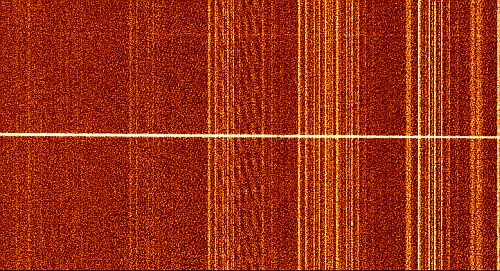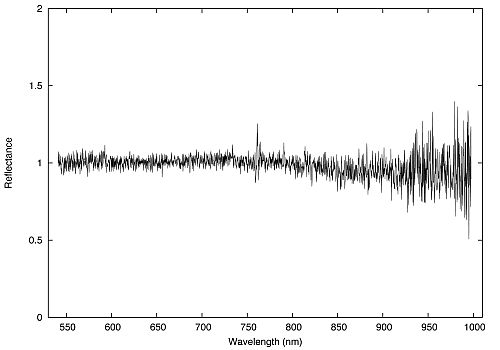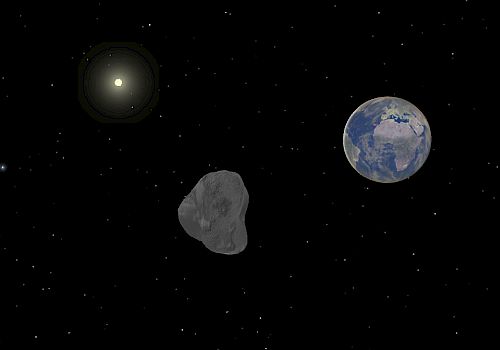First Ever Spectrum of an Asteroid Which Hit the Earth
ING web news release
25th March, 2009
Having less than 24 hours in which to act, astronomers using the William Herschel Telescope have been able to obtain the only spectrum of an asteroid which hit the Earth,
establishing the first direct link between an asteroid and a meteorite.
The asteroid in question, 2008 TC3, was first
sighted by US telescopes on 6th October 2008 and subsequent observations by an army of professional and amateur astronomers led to the discovery that it was due to enter the atmosphere
the following morning. Only 4 and a half hours before the
impact, UK astronomers were able to use the ISIS spectrograph to study its size and composition, and predict whether it would explode and break up in the atmosphere or reach the
ground. 2008 TC3 eventually exploded and some small fragments were recovered in Sudan, East Africa. These results are published in the March 26th issue of Nature.
"This was the first ever predicted impact of an asteroid with the Earth," said Prof. Alan Fitzsimmons of Queen's University Belfast. "The faint observed brightness
implied a small size, which in turn meant there was little advance warning. It was important to try and figure out what type of asteroid it was before impact,
which would give us a better idea of how it would interact with the atmosphere, its likely size and where it came from."
Fellow researcher Dr. Henry Hsieh and PhD student Mr. Sam Duddy were undertaking another project at the William Herschel Telescope, and the astronomer scheduled to use the telescope
that night, Dr. Gavin Ramsay from Armagh Observatory, appreciated the importance of the event and readily agreed to assist
in observing the asteroid. Only 4 and a half hours before impact, they used the ISIS spectrograph to measure how light was reflected from the surface of the asteroid.

 |
Top: Spectrum of asteroid 2008 TC3 as seen at the William Herschel Telescope using the ISIS spectrograph (the horizontal bright line). [ JPEG ]. Bottom: Spectrum of the asteroid showing how it
reflected light as a function of wavelength. This spectrum implied the asteroid had originated in the outer part of the main asteroid belt.
The meteoritical analysis proved this and together gave the first
direct link between an asteroid and a meteorite. [ JPEG ].
|
Sam Duddy explained "When we found we could observe the asteroid from the William Herschel Telescope it was an exciting couple of hours planning the details of the observations
we would conduct. Actually performing the observations of an object that was certain to impact the atmosphere was a great but challenging experience."
"These observations were technically quite difficult since the object was moving fast across the sky," said Gavin Ramsay. "However, the William Herschel Telescope
rose to the challenge magnificently and demonstrated just what a versatile telescope it is. There was a keen sense of excitement in the control room!"
 |
Simulated image looking from behind asteroid 2008 TC3 towards the Earth and Sun, at the time the spectrum was taken from
La Palma. At this time the asteroid was 4 hours 20 minutes from impact, it was only 113,000 km from Earth and moving towards the Earth at
6.8 km/sec. The red dot on Earth shows the location of the William Herschel Telescope. [ JPEG | TIFF ]. A quicktime movie showing the
trajectory of the asteroid from the time the spectrum was obtained until impact is also available. Time has been sped up by factors of 100 and 1000, so that the 4.3 hours lasts only 72 and 16 seconds
respectively. The red dots on Earth show the location of La Palma, and Clay Center Observatory in the US, used to measure its spin period. [ MOV (100 speed-up factor, 45MB) | MOV (1000 speed-up factor, 10MB) ].
|
As explained in the Nature article, some small fragments survived the high-altitude explosion that
vaporised most of the asteroid. The lead author of the
article, astronomer Dr. Peter Jenniskens of the SETI institute in California, teamed up with Dr. Muawia Shaddad and 45 students and staff of the University of
Khartoum to search the Nubian Desert in Sudan for meteorites. In the first search campaign on 5th-8th December 2008, 15 meteorites were recovered over an area stretching 29 kilometres along the calculated approach path of the 4-meter sized asteroid. In later searches, a total of 4 kilograms of meteorites was found, which still accounts for only a small
fraction of the 80 tonnes that crashed in the Earth's atmosphere.
"This asteroid was made of a particularly fragile material that caused it to explode at a high altitude of 37 kilometres , before it was significantly slowed down, so that the
few surviving fragments scattered over a large area", explains Jenniskens. "The recovered meteorites were unlike anything in our meteorite collections up to that point."
After measuring how the meteorites reflected light, it was discovered that the spectra of the asteroid and meteorites agree well, which implies that the asteroid was
not covered in dust and did not have much weathering from radiation in space. More importantly, the team found that 2008 TC3 was a rare type of asteroid, called F-class,
corresponding to dark ureilite achondrite meteorites with a texture and composition unlike any other ureilite meteorites found on Earth.
Contacts:
-
Prof. Alan Fitzsimmons
Astrophysics Research Centre
Queen's University Belfast
Belfast BT7 1NN
Email: a.fitzsimmons qub.ac.uk qub.ac.uk
- Dr. Henry Hsieh
Astrophysics Research Centre
Queen's University Belfast
Belfast BT7 1NN
Email: h.hsieh qub.ac.uk qub.ac.uk
-
Mr. Sam Duddy
Astrophysics Research Centre
Queen's University Belfast
Belfast BT7 1NN
Email: sduddy02 qub.ac.uk qub.ac.uk
-
Dr. Gavin Ramsay
Armagh Observatory
College Hill
Armagh BT61 9DG
Email: gar arm.ac.uk arm.ac.uk
More information:
-
Movie of asteroid 2008 TC3 obtained by Jure Skvarc (Isaac Newton
Group of Telescopes) at the Crni Vrh Observatory, Slovenia. The movie shows the
apparent motion of the asteroid against the background stars between
7.5 hours and 5 hours before impact, as it moved from 190,000 km
distance to just 125,000 km from Earth: AVI (56MB).
- Asteroid 2008TC3 was discovered by the telescopes of the Catalina Sky Survey.
- P. Jenniskens, M. H. Shaddad, D. Numan, S. Elsir, A. M. Kudoda, M. E. Zolensky, L. Le, G. A. Robinson, J. M. Friedrich, D. Rumble, A. Steele, S. R. Chesley, A. Fitzsimmons, S. Duddy, H. H. Hsieh, G. Ramsay, P. G. Brown, W. N. Edwards, E. Tagliaferri, M. B. Boslough, R. E. Spalding, R. Dantowitz, M. Kozubal, P. Pravec, J. Borovicka, Z. Charvat, J. Vaubaillon, J. Kuiper, J. Albers, J. L. Bishop, R. L. Mancinelli, S. A. Sandford, S. N. Milam, M. Nuevo & S. P. Worden,
2009, "The impact and recovery of asteroid 2008 TC3", Nature, 458, 485.
- "UK astronomers observe asteroid before it crashes into Earth", STFC press release, 25th March 2009.
- "Surprise Recovery of Meteorites Following Asteroid Impact", SETI press release, 25th March, 2009.
Available formats: HTML | TXT.
|
|



